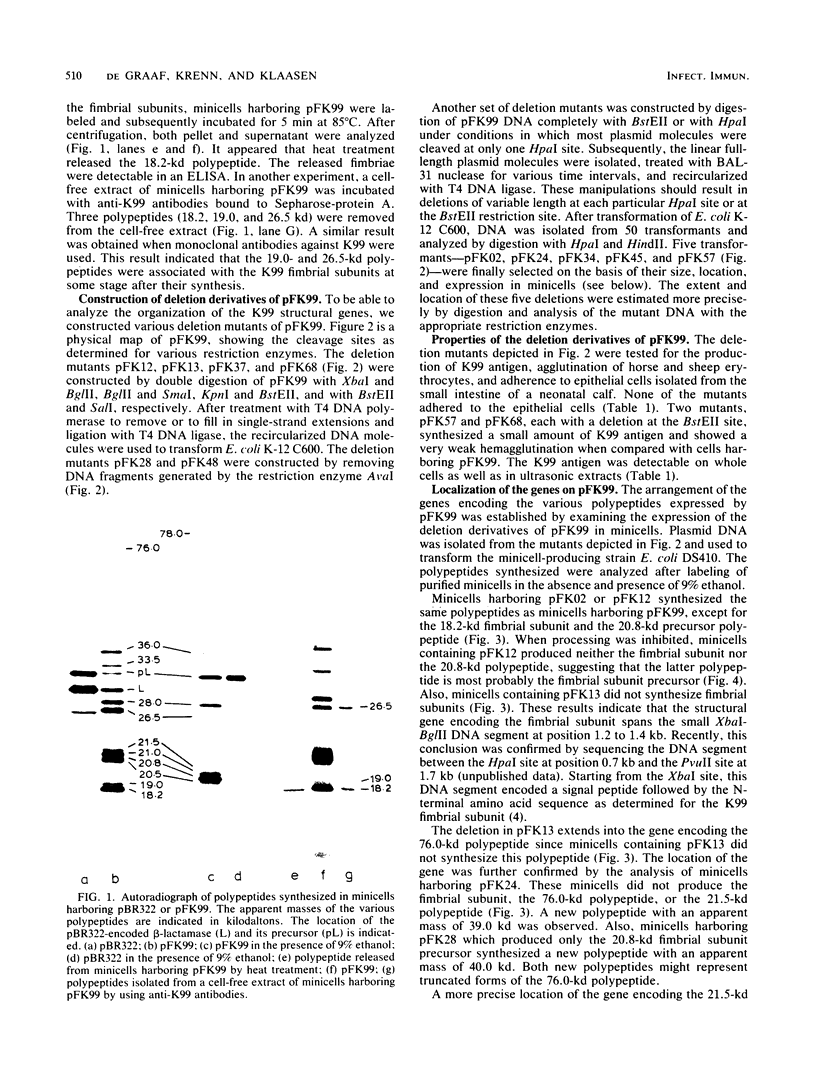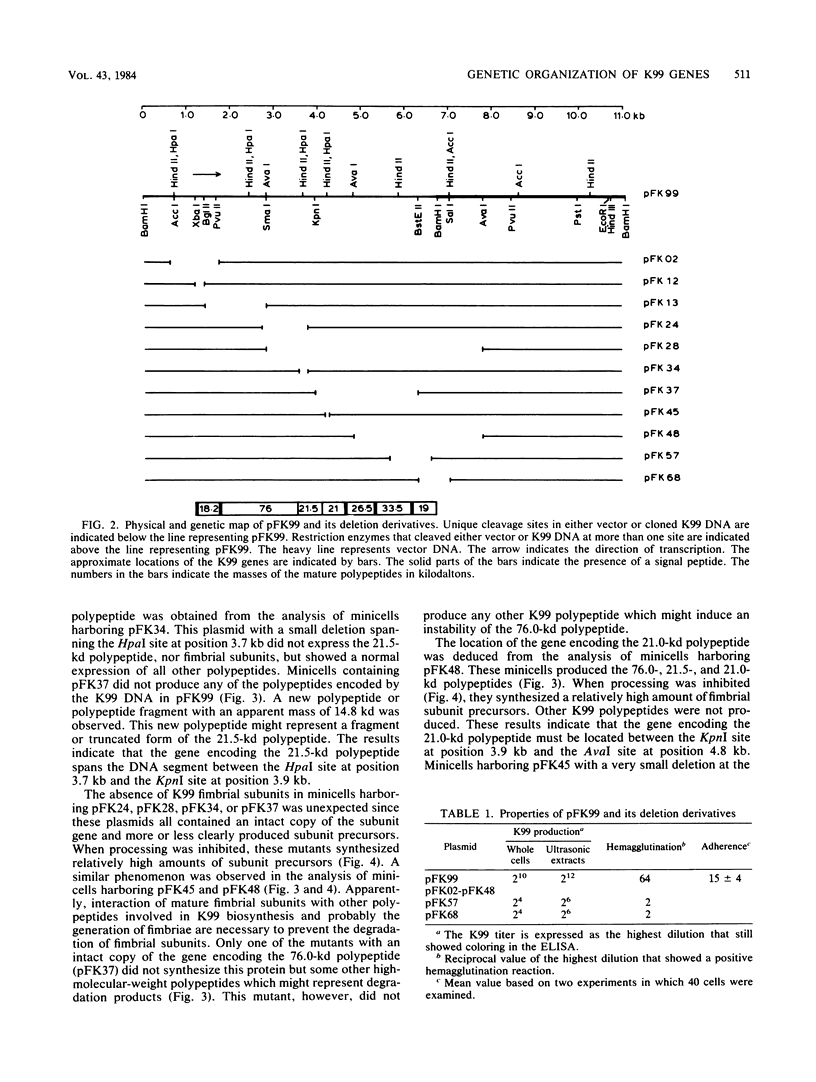Abstract
Escherichia coli K-12 minicells were used to study the expression of plasmid pFK99 encoding for the production of K99 fimbriae. Plasmid pFK99 is composed of a 6.7-kilobase pair DNA fragment derived from the wild-type K99 plasmid and the vector pBR322. The cloned K99 DNA expressed seven polypeptides with apparent masses of 18.2, 19.0, 21.0, 21.5, 26.5, 33.5, and 76.0 kilodaltons (kd). The 18.2-kd polypeptide was identified as the K99 fimbrial subunit by reaction with specific anti-K99 antibodies. The fimbrial subunit and the 19.0-, 26.5-, 33.5-, and 76.0-kd polypeptides appeared to be synthesized in a precursor form which was ca. 2 kd larger than the mature polypeptide. The location of the structural genes encoding the seven polypeptides on the physical map of pFK99 was established by analyzing a set of deletion derivatives of pFK99. The gene encoding the fimbrial subunit was located at the promoter proximal end of the K99 operon. Only mutants with a deletion in the gene encoding the 33.5- or the 19.0-kd polypeptide or both showed a weak expression of the K99 antigen and a comparably weak agglutination of horse or sheep erythrocytes. None of the deletion mutants was able to adhere to calf intestinal epithelial cells.
Full text
PDF






Images in this article
Selected References
These references are in PubMed. This may not be the complete list of references from this article.
- Birnboim H. C., Doly J. A rapid alkaline extraction procedure for screening recombinant plasmid DNA. Nucleic Acids Res. 1979 Nov 24;7(6):1513–1523. doi: 10.1093/nar/7.6.1513. [DOI] [PMC free article] [PubMed] [Google Scholar]
- Dagert M., Ehrlich S. D. Prolonged incubation in calcium chloride improves the competence of Escherichia coli cells. Gene. 1979 May;6(1):23–28. doi: 10.1016/0378-1119(79)90082-9. [DOI] [PubMed] [Google Scholar]
- Eden C. S., Eriksson B., Hanson L. A. Adhesion of Escherichia coli to human uroepithelial cells in vitro. Infect Immun. 1977 Dec;18(3):767–774. doi: 10.1128/iai.18.3.767-774.1977. [DOI] [PMC free article] [PubMed] [Google Scholar]
- Girardeau J. P., Dubourguier H. C., Gouet P. Inhibition of K99 antigen synthesis by L-alanine enterotoxigenic Escherichia coli. J Gen Microbiol. 1982 Mar;128(3):463–470. doi: 10.1099/00221287-128-3-463. [DOI] [PubMed] [Google Scholar]
- Guinée P. A., Jansen W. H., Agterberg C. M. Detection of the K99 antigen by means of agglutination and immunoelectrophoresis in Escherichia coli isolates from calves and its correlation with entertoxigenicity. Infect Immun. 1976 May;13(5):1369–1377. doi: 10.1128/iai.13.5.1369-1377.1976. [DOI] [PMC free article] [PubMed] [Google Scholar]
- Laemmli U. K. Cleavage of structural proteins during the assembly of the head of bacteriophage T4. Nature. 1970 Aug 15;227(5259):680–685. doi: 10.1038/227680a0. [DOI] [PubMed] [Google Scholar]
- Middeldorp J. M., Witholt B. An in vitro system to study interactions between bacteria and epithelial cells at the molecular level. J Gen Microbiol. 1983 Jan;129(1):179–190. doi: 10.1099/00221287-129-1-179. [DOI] [PubMed] [Google Scholar]
- Mooi F. R., Harms N., Bakker D., de Graaf F. K. Organization and expression of genes involved in the production of the K88ab antigen. Infect Immun. 1981 Jun;32(3):1155–1163. doi: 10.1128/iai.32.3.1155-1163.1981. [DOI] [PMC free article] [PubMed] [Google Scholar]
- Mooi F. R., Wijfjes A., de Graaf F. K. Identification and characterization of precursors in the biosynthesis of the K88ab fimbria of Escherichia coli. J Bacteriol. 1983 Apr;154(1):41–49. doi: 10.1128/jb.154.1.41-49.1983. [DOI] [PMC free article] [PubMed] [Google Scholar]
- Mooi F. R., Wouters C., Wijfjes A., de Graaf F. K. Construction and characterization of mutants impaired in the biosynthesis of the K88ab antigen. J Bacteriol. 1982 May;150(2):512–521. doi: 10.1128/jb.150.2.512-521.1982. [DOI] [PMC free article] [PubMed] [Google Scholar]
- Mooi F. R., de Graaf F. K., van Embden J. D. Cloning, mapping and expression of the genetic determinant that encodes for the K88ab antigen. Nucleic Acids Res. 1979 Mar;6(3):849–865. doi: 10.1093/nar/6.3.849. [DOI] [PMC free article] [PubMed] [Google Scholar]
- Moon H. W., Nagy B., Isaacson R. E., Orskov I. Occurrence of K99 antigen on Escherichia coli isolated from pigs and colonization of pig ileum by K99+ enterotoxigenic E. coli from calves and pigs. Infect Immun. 1977 Feb;15(2):614–620. doi: 10.1128/iai.15.2.614-620.1977. [DOI] [PMC free article] [PubMed] [Google Scholar]
- Palva E. T., Hirst T. R., Hardy S. J., Holmgren J., Randall L. Synthesis of a precursor to the B subunit of heat-labile enterotoxin in Escherichia coli. J Bacteriol. 1981 Apr;146(1):325–330. doi: 10.1128/jb.146.1.325-330.1981. [DOI] [PMC free article] [PubMed] [Google Scholar]
- Rodriguez R. L., West R. W., Heyneker H. L., Bolivar F., Boyer H. W. Characterizing wild-type and mutant promoters of the tetracycline resistance gene in pBR313. Nucleic Acids Res. 1979 Jul 25;6(10):3267–3287. doi: 10.1093/nar/6.10.3267. [DOI] [PMC free article] [PubMed] [Google Scholar]
- Smith H. W., Linggood M. A. Further observations on Escherichia coli enterotoxins with particular regard to those produced by atypical piglet strains and by calf and lamb strains: the transmissible nature of these enterotoxins and of a K antigen possessed by calf and lamb strains. J Med Microbiol. 1972 May;5(2):243–250. doi: 10.1099/00222615-5-2-243. [DOI] [PubMed] [Google Scholar]
- So M., Boyer H. W., Betlach M., Falkow S. Molecular cloning of an Escherichia coli plasmid determinant than encodes for the production of heat-stable enterotoxin. J Bacteriol. 1976 Oct;128(1):463–472. doi: 10.1128/jb.128.1.463-472.1976. [DOI] [PMC free article] [PubMed] [Google Scholar]
- de Graaf F. K., Klaasen-Boor P., van Hees J. E. Biosynthesis of the K99 surface antigen is repressed by alanine. Infect Immun. 1980 Oct;30(1):125–128. doi: 10.1128/iai.30.1.125-128.1980. [DOI] [PMC free article] [PubMed] [Google Scholar]
- de Graaf F. K., Klemm P., Gaastra W. Purification, characterization, and partial covalent structure of Escherichia coli adhesive antigen K99. Infect Immun. 1981 Sep;33(3):877–883. doi: 10.1128/iai.33.3.877-883.1981. [DOI] [PMC free article] [PubMed] [Google Scholar]
- de Graaf F. K., Wientjes F. B., Klaasen-Boor P. Production of K99 antigen by enterotoxigenic Escherichia coli strains of antigen groups o8, o9, o20, and o101 grown at different conditions. Infect Immun. 1980 Jan;27(1):216–221. doi: 10.1128/iai.27.1.216-221.1980. [DOI] [PMC free article] [PubMed] [Google Scholar]
- van Embden J. D., de Graaf F. K., Schouls L. M., Teppema J. S. Cloning and expression of a deoxyribonucleic acid fragment that encodes for the adhesive antigen K99. Infect Immun. 1980 Sep;29(3):1125–1133. doi: 10.1128/iai.29.3.1125-1133.1980. [DOI] [PMC free article] [PubMed] [Google Scholar]





